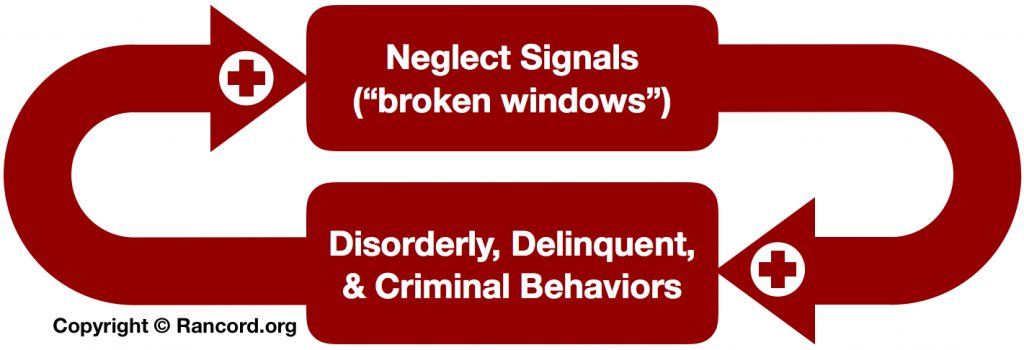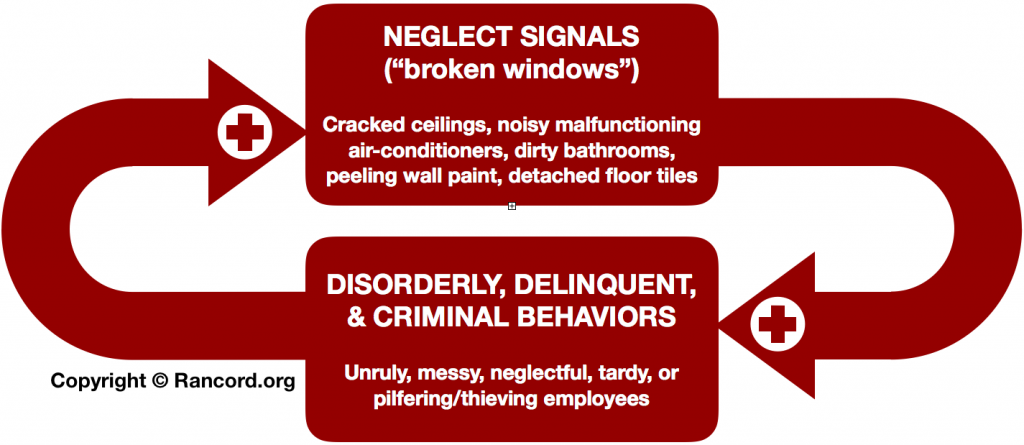
Applying the Broken Windows theory in workplace management and operations management can benefit businesses, especially in minimizing costs associated with undesirable employee behaviors. This business application is extendable to other aspects of operations, such as stakeholder management and various administrative activities. The Broken Windows theory is a criminological framework for understanding human behavioral effects of the physical environment, especially with regard to policing communities for disorderly conduct, delinquency, and crime. Even though this theory is criminological, it has diverse possible applications in the business world. The emphasis on human behavior makes the theory applicable in settings that require managing or influencing people’s behaviors. Business managers can use the Broken Windows theory to strategically enhance workforce performance through the reduction of undesirable employee behavior, and to encourage positive customer behavior toward the business organization and its products. Policing the enterprise in this way can reduce barriers to operational effectiveness and business success.
There are various practical applications of the Broken Windows policing theory in non-business situations. Nonetheless, companies stand to benefit from the cost-efficiencies linked to the theory’s application in strategies for social control. Business leaders must aim to eliminate “broken windows” to create an image of management effectiveness, systematization, efficiency, quality, care, and round-the-clock surveillance.
Overview of the Broken Windows Theory
Although originally introduced in 1982, the Broken Windows theory is popularly known for its application in New York City’s police operations under the leadership of Mayor Giuliani. The main idea is that a neglected and disorderly environment encourages further neglect and disorder, which makes policing and public administration more difficult. The resulting condition leads to higher probabilities of criminal activity. The “broken windows” symbolize the manifestations of neglect and disorder, such as broken windowpanes, graffiti, and unattended trash piles. The theory asserts that restoring order in the visual physical environment reduces misdemeanor and crime. Overt monitoring of the physical environment, such as through surveillance cameras, also contributes to the reduction of disorder and crime.
The relationship between the physical environment and human behavior is depicted in the following positive feedback loop diagram that represents the theoretical principles and concept of broken windows policing:

This diagram is a simple representation of the flow of positive reinforcement between the neglect indicators or signals and people’s behaviors in the environment in question. Administrative and public neglect signals, such as broken windowpanes, could increase the likelihood of people’s disorderly, delinquent, and criminal behaviors. In turn, these behaviors lead to further neglect signals, such as through vandalism. Thus, the scenario is that of a positive feedback loop. Theoretical explanations for this cycle of reinforcement include visual cues, such as broken windows, which may indicate the neglect of and lack of consequences on disorder and crime. Social conformism is another factor: People have the tendency to conform to what they think others are doing, such as neglecting disorder or vandalizing seemingly neglected buildings.
Broken Windows Policing in Workplace Administration in Enterprises
Workplaces involve employees, whose behaviors determine organizational effectiveness. This aspect of business organizations typically requires human resource management programs to optimize workers’ performance by influencing their behaviors. The effects of the physical characteristics of the workplace are a basic consideration in administering that involves a form of broken windows policing. This is where the Broken Windows theory relates to business organizations, especially in managing the workplace environment. In the context of enterprises and their administrative efforts, the following diagram expands the simple feedback loop illustrated in the previous diagram of the Broken Windows theory:

In enterprises, the physical environment involves the space where employees perform their jobs. According to the Broken Windows theory, the characteristics of this space influence workers’ individual and group behaviors. Signs of neglect and disorder can lead to further neglect and disorder among workers. In relation to the diagram, examples of “broken windows” or neglect signals in the business management and strategy context include disorderly office files and folders, disorganized desks, rusty doors, moldy ceilings, and peeling paint.
A direct application of the Broken Windows theory in business management is through the removal or reduction of neglect signals. For example, company managers can use workplace maintenance programs to immediately repair damage or to replace furniture and fixtures when needed. Damaged and malfunctioning spaces, furniture, and equipment are the workplace’s “broken windows” or neglect signals, based on the Broken Windows policing theory. Implementing a suitable form of broken windows policing, companies and their managers can expect lower likelihood of employees engaging in disorderly, deviant, or criminal behaviors in the workplace. The presence of even one “broken window” can have a significant effect on employees’ engagement in workplace violence, delinquency, or criminal activity, and could potentially lead to a “broken business.”
Extending the social control application of the Broken Windows theory, business managers can encourage desirable behaviors among employees by enhancing the physical characteristics of the workplace, especially those characteristics that the employees readily observe. These characteristics are the visual cues that influence workers’ perceptions and corresponding behaviors toward the company. For example, to achieve higher rates of exchange of innovative ideas among employees, business administrators can minimize “broken windows” or neglect signals, such as visual obstructions and other physical barriers to communication between offices, desks, or cubicles. These barriers lead to the perception that the company neglects employees’ psychosocial needs.
Integrating the Broken Windows theory into business policies can strengthen companies’ financial performance. For example, including the theory in human resource management policies and strategies can enhance the outcomes of employee training programs and leadership development. This “broken windows policing” of the enterprise environment should consider the design of training venues and the characteristics of materials and equipment used. Orderliness, cleanliness, and an overall streamlined layout and design of workplaces influence employees to adopt behaviors that comply with business rules. Business managers can expect compliant employee behavior through the use of clean and properly functioning materials and equipment. This business strategy of using the Broken Windows theory for higher business performance via human resource management requires the reduction or elimination of “broken windows,” which include improperly constructed venues, inefficient layouts, disorganized materials, rusty and malfunctioning equipment, and dusty floors and seats.
Broken Windows Theory in Managing Customer Behaviors
Customer behavior management is another business area where the Broken Windows theory is applicable. This area involves strategies and administrative activities that encourage customers to maintain behaviors that are desirable to company. For example, retailers aim to reduce customers’ misdemeanor and increase their purchase rates. Managers may apply the Broken Windows theory through strategies and tactics that increase customers’ likelihood of maintaining orderly behavior while in the company’s premises. These strategies and tactics include maintaining a neat and spotless store, which creates the perception that the business does not neglect its premises and that the company provides high-quality products. As a form of social control, this “broken windows policing” of customers makes them have a favorable perception about the company, and deter them from littering or vandalizing the place. They are motivated to keep orderly behavior. As a case example, businesses such as McDonald’s restaurants (intentionally or unintentionally) apply the Broken Windows theory in keeping high standards of sanitation and orderliness. A neat and clean restaurant creates an image of crew effectiveness.
Other Business Applications of the Broken Windows Theory
Aside from HR management and customer behavior management, the Broken Windows theory is applicable in other administrative areas of businesses. For example, Business managers could implement the theory in spaces where they transact or interact with suppliers and third-party service providers. In retailers like Walmart, the condition of warehouses or delivery bays influences supplier personnel’s interactions with the retailer’s employees. An orderly warehouse helps establish an image of systematic processes, which motivate suppliers’ representatives to be systematic, as well. Similarly, companies may apply the Broken Windows theory in physical environments where they interact with business partners. These environments include meeting rooms, where the presence or absence of “broken windows” influence negotiators’ perceptions and the outcomes of business negotiations and agreements. Applying the Broken Windows theory in business strategic management affects branding and corporate image. For example, “broken windows policing” of marketing venues, such as in trade shows, can optimize marketing effectiveness and, consequently, business performance.
References
- Bratton, W. J. (2016). Broken Windows is Not Broken: The NYPD Response to the Inspector General’s Report on Quality-of-Life Enforcement. City of New York.
- Jenkins, M. J. (2016). Police support for community problem-solving and broken windows policing. American Journal of Criminal Justice, 41(2), 220-235.
- Kelling, G. L., & Coles, C. M. (1997). Fixing broken windows: Restoring order and reducing crime in our communities. Simon and Schuster.
- Kotabe, H. P., Kardan, O., & Berman, M. G. (2016). The order of disorder: Deconstructing visual disorder and its effect on rule-breaking. Journal of Experimental Psychology: General, 145(12), 1713-1727.
- Mahoney, T. A., & Deckop, J. R. (1986). Evolution of concept and practice in personnel administration/human resource management (PA/HRM). Journal of Management, 12(2), 223-241.
- Martinko, M. J., Douglas, S. C., & Harvey, P. (2006). Understanding and Managing Workplace Aggression. Organizational Dynamics, 35(2), 117-130.
- Morris, J. A., & Feldman, D. C. (1997). Managing emotions in the workplace. Journal of Managerial Issues, 9(3), 257.
- Muniz, A. (2012). Disorderly community partners and broken windows policing. Ethnography, 13(3), 330-351.
- Priluck Grossman, R. (1998). Developing and managing effective consumer relationships. Journal of Product & Brand Management, 7(1), 27-40.
- Ren, L., Zhao, J. S., & He, N. P. (2017). Broken Windows Theory and Citizen Engagement in Crime Prevention. Justice Quarterly, 1-30.
- Reynolds, K. L., & Harris, L. C. (2006). Deviant customer behavior: An exploration of frontline employee tactics. Journal of Marketing Theory and Practice, 14(2), 95-111.
- Salin, D. (2015). Risk factors of workplace bullying for men and women: The role of the psychosocial and physical work environment. Scandinavian Journal of Psychology, 56(1), 69-77.
- Sandelands, L., Glynn, M. A., & Larson Jr., J. R. (1991). Control theory and social behavior in the workplace. Human Relations, 44(10), 1107-1130.
- Suliman, A. M., & Abdulla, M. H. (2005). Towards a high-performance workplace: managing corporate climate and conflict. Management Decision, 43(5), 720-733.
- Timm, S., Gray, W. A., Curtis, T., & Chung, S. S. E. (2018). Designing for health: How the physical environment plays a role in workplace wellness. American Journal of Health Promotion, 32(6), 1468-1473.
- Trice, H. M. (1989). Social control in the workplace. Psyccritiques, 34(1), 56-58.
- Vischer, J. C., & Wifi, M. (2017). The effect of workplace design on quality of life at work. In Handbook of Environmental Psychology and Quality of Life Research (pp. 387-400). Springer, Cham.
- Weisburd, D., Hinkle, J. C., Braga, A. A., & Wooditch, A. (2015). Understanding the mechanisms underlying broken windows policing: The need for evaluation evidence. Journal of Research in Crime and Delinquency, 52(4), 589-608.
- Welsh, B. C., Braga, A. A., & Bruinsma, G. J. (2015). Reimagining broken windows: From theory to policy. Journal of Research in Crime and Delinquency, 52(4), 447-463.
- Zhou, X., Liao, J. Q., Liu, Y., & Liao, S. (2017). Leader impression management and employee voice behavior: Trust and suspicion as mediators. Social Behavior and Personality: An International Journal, 45(11), 1843-1854.
